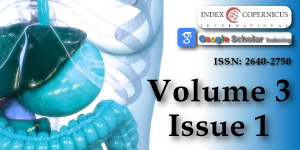An uncommon cause of isolated ascites: Pseudomyxoma peritonei
Main Article Content
Abstract
Pseudomyxoma peritonei or Gelatinous Peritoneal Disease is a rare disease. We report a case treated in the department of Hepato-Gastroenterology at Ibn Sina Hospital in Rabat, of a 64-year-old male who presented with an abdominal pain and an increased volume of the abdomen corresponding to ascites. Imaging and anatomopathological study made it possible to diagnose the disease. However, given the general state of the patient, he is under palliative care.
Article Details
Copyright (c) 2019 Hady L, et al.

This work is licensed under a Creative Commons Attribution 4.0 International License.
Shih IM, Yan H, Speyrer D, Shmookler BM, Sugarbaker PH, et al. Molecular genetic analysis of appendiceal mucinous adenomas in identical twins, including one with pseudomyxoma peritonei. Am J Surg Pathol. 2001; 25: 1095-1099. Ref.: https://tinyurl.com/y2ks76zw
Smeenk RM, van Velthuysen ML, Verwaal VJ, Zœtmulder FA. Appendiceal neoplasms and pseudomyxoma peritonei: a popu- lation based study. Eur J Surg Oncol. 2008; 4: 196-201. Ref.: https://tinyurl.com/y5x4qr2h
Elias D, Gilly F, Quenet F, Bereder JM, Sidéris L, et al. Pseudomyxoma peritonei: a French multicentric study of 301 patients treated with cytoreductive surgery and intraperi- toneal chemotherapy. Eur J Surg Oncol. 2010; 36: 456-462. Ref.: https://tinyurl.com/yy3w6cl6
Moran BJ, Cecil TD. The etiology, clinical presentation, and management of pseudomyxoma peritonei. Surg Oncol Clin N Am. 2003; 12: 585–603. Ref.: https://tinyurl.com/y5z72s2j
Esquivel J. Sugarbaker PH. Clinical presentation of pseudomyxoma peritonei syndrome. Br J Surg. 2000; 87: 1414–1418. Ref.: https://tinyurl.com/y48vnspq
Smeenk RM, Bruin SC, van Velthuysen ML, Verwaal VJ. Pseudomyxoma peritonei. Curr Probl Surg. 2008; 45: 527-575. Ref.: https://tinyurl.com/y4yskvch
Fallis SA, Moran BJ. Management of pseudomyxoma peritonei. J BUON. 2015; 20: S47–S55. Ref.: https://tinyurl.com/y2pmyarq
Sulkin TV, O’Neill H, Amin AI, Moran B. CT in pseudomyxoma peritonei: a review of 17 cases. Clin Radiol. 2002; 57: 608-613. Ref.: https://tinyurl.com/y38dv33k
Passot G, Glehen O, Pellet O, Isaac S, Tychyj C, et al. Pseudomyxoma peritonei: role of 18F-FDG PET in preo- perative evaluation of pathological grade and potential for complete cytoreduction. Eur J Surg Oncol. 2010; 36: 315-323. Ref.: https://tinyurl.com/yxscjfw7
Koh JL, Liauw W, Chua T, Morris DL. Carbohydrate anti- gen 19-9 (CA 19-9) is an independent prognostic indicator in pseudomyxoma peritonei post cytoreductive surgery and per- ioperative intraperitoneal chemotherapy. J Gastrointest Oncol. 2013; 4: 173-181. Ref.: https://tinyurl.com/y52ahtms
Carmignani CP, Hampton R, Sugarbaker CE, Chang D, Sugarbaker PH. Utility of CEA and CA 19-9 tumor markers in diagnosis and prognostic assesment of mucinous epithelial cancer of the appendix. J Surg Oncol. 2004; 87: 162-166. Ref.: https://tinyurl.com/y5aaxwrt
Dartigues P, Isaac S, Villeneuve L, Glehen G, Capovilla M, et al. Mise au point sur le pseudo-myxome péritonéal. Aspects anatomopathologiques, et implications thérapeutiques. Ann Pathol. 2014; 34: 14–25. Ref.: https://tinyurl.com/y5beavaw
Sugarbaker PH. Surgical treatment of peritoneal carcinomatosis: 1988 Du Pont lecture. Can J Surg. 1989; 32: 164-170. Ref.: https://tinyurl.com/yxlz9h6a
Moran B, Baratti D, Yan TD, Kusamura S, Deraco M. Consensus statement on the loco-regional treatment of appendiceal muci- nous neoplasms with peritoneal dissemination (pseudomyxoma peritonei). J Surg Oncol. 2008; 98: 277-282. Ref.: https://tinyurl.com/yy5hsfuh
Yan TD, Bijelic L, Sugarbaker PH. Critical analysis of treatment failure after complete cytoreductive surgery and perioperative intraperitoneal chemotherapy for peritoneal dissemination from appendiceal mucinous neoplasms. Ann Surg Oncol. 2007; 14: 2289-2299. Ref.: https://tinyurl.com/y5xowepd
Chua TC, Moran BJ, Sugarbaker PH, Levine EA, Glehen O, et al. Early- and long-term outcome data of patients with pseudomyxoma peritonei from appendiceal origin treated by a strategy of cytoreductive surgery and hyperthermic intraperitoneal chemotherapy. J Clin Oncol. 2012; 30: 2449-2456. Ref.: https://tinyurl.com/yxftnuzu

